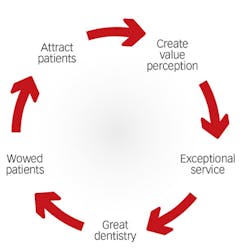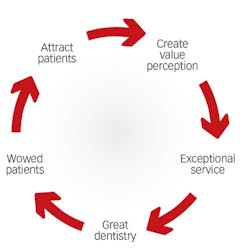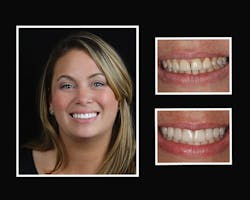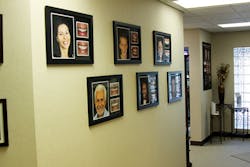Building a fee-for-service practice: The value-driven alternative to dentistry as a commodity
Why do patients ask if you take their insurance? If they view dentistry as a commodity, then going somewhere that "takes" their insurance is logical. A crown is a crown—right? How did dentistry go from fee for service to an ever increasingly insurance-driven commodity?
Maybe it started with insurance and the creation of procedure codes for the purpose of processing claims efficiently. A porcelain veneer became a 2962. It is the same code and the same fee allowance, regardless of doctor, technician, material, degree of difficulty, and the expectations of the patient. How can there be a single code—a single fee, no less—to encompass the many permutations of a porcelain veneer restoration?
Maybe it started when advertising was first allowed in dentistry; it's hard to believe that there was a time when it was not. Dental advertising evolved into marketing campaigns often focused on product and pricing, a strategy used in retail, a commodity-based industry. Then, with the growing competition for product branding, DenMat launched its original Lumineer marketing campaign. Consumer awareness of and demand for veneers skyrocketed, to the benefit of many dentists. But having patients calling to ask for specific products reinforced the commodity association and the idea of "product first, provider second." The trend continues, furthering the idea that dentistry is a marketable product, with branding for implants, clear braces, zirconia crowns, whitening, and more. In a fee-for-service practice (FFSP), you are unbound by codes and set fees, creating opportunities to provide the best outcomes in the least invasive ways, thereby creating value for the patient.
How can a value-driven practice buck the commodity trap?
Patients may assert that cost is the determining factor in accepting treatment, but often money is a convenient scapegoat. Two important barriers to treatment that are often not verbalized are (1) perceived value and (2) trust. If patients see little value in what you are proposing or they don't trust that you can deliver the results they desire—or the dentist down the road can deliver the same and he takes their insurance—you won't be doing the treatment.
After the value for treatment is communicated and understood, the next hurdle is gaining patients' that you are not only capable, but what you have to offer is unique and worth more than what their insurance may cover. If patients recognize this, the difference in fees from one dentist to another will become secondary and treatment acceptance will be high. So how do you develop this type of trust, especially with new patients? You need to move away from commodities and toward a value-driven practice.
The following are strategies to decommoditize your practice.
Attract patients
• Website and marketing: Move the focus of your marketing away from products and toward solutions. A website featuring lists of the same old services (e.g., crowns, implants, veneers, tooth-colored fillings) only lumps you in with every other commodity-based dentist. My before-and-after photos, for example, are the most viewed pages on my site. I use a three-photo collage with the "after" portrait being the largest. Patients need to identify with a "before" photo (e.g., "That looks like my teeth!") and then see the result-a happy, beautiful smile (e.g., "That's what I want"). See Figure 1 for an example of a collage.
Create value perception
• Be welcoming: Patients have limited ways of evaluating a practice and, essentially, you. Is the office clean? Is the staff friendly? Did it "hurt"? I routinely walk in through the main entrance of my office to see how my waiting room appears to patients. I listen to how my staff greets and converses with them. The office doesn't look clean and updated? Game over. Your staff is too busy to greet each patient in a friendly and professional manner? Game over.
• Photography: One of the first courses the American Academy of Cosmetic Dentistry recommends taking in preparation for accreditation is photography. Quality photos allow you to truly evaluate your work and improve your techniques. Excellent photography also serves to demonstrate your competency. Presenting cases you personally completed with high-quality photography is powerful. Compile a portfolio of before-and- after photos sorted by specific case types. Every case is unique, but there is a finite set of case types that most patients can identify with. If a patient has peg laterals, I show my peg lateral cases, and so on. Build your portfolio, case by case, and set up a monitor with a slide show or decorate your office with your dental art. My main hallway leading to the treatment rooms features my best of each case type, showing patients what is possible before they are even seated (figure 2).
• Professional achievements: There is a fine line between blatant self-promotion and communicating your qualifications to prospective patients. Well-informed patients will question accolades such as "voted best dentist." Every doctor has a wall covered with framed certificates; after the third or fourth they become wallpaper and lose their value. Try to have more personal achievements and meaningful awards on display. Trust levels increase when patients believe credentials are legitimate and differentiate you from others.
Provide exceptional service
• Respect: Run on time. This is an area in which you can distinguish yourself from an insurance practice. Although patients are becoming accustomed to long waits at doctors' offices, wow them by seeing them promptly. Respect their time and they will respect yours.
Figure 1: An example of a three-photo collage
Figure 2: The author's main hallway with collages
• Fairness: I was eavesdropping at a conference (you know you do too!) and heard a group of dentists discussing their crown fees. After numbers were bandied about, the last to join in said, "I charge $2,500 a crown." After some oohs and aahs, another said, "But I thought you had an insurance practice?" The dentist replied, "I do, so I only get to charge my crown fee a few times a year when someone without insurance walks in." Is this fair? Why do we charge our potentially most sought after patients more than our insurance patients? How about this: Charge a fair fee to all your patients and don't nickel-and-dime them like many insurance practices feel compelled to do. Fairness doesn't mean cheapness: It means establishing a fee that reflects the value of the services provided.
• Feeling special: At the core of every person is a desire to feel special. Make someone feel special and they won't think of you as a commodity. Best Buy sells commodities; you don't feel special when you walk into Best Buy despite the security guard's well-scripted "Welcome to Best Buy" and the salesperson's formal training on "conversation starter topics" and "the permission question." You are there to get a TV; you want the best buy! Creating this feeling goes beyond scripting-it begins with listening and really being interested in what patients have to say. Keep it real. No one likes a phony. For many patients, having their "teeth fixed" is their one moment in the spotlight. It may be routine for you but not for them. Make the most of this opportunity and they won't care if you take their insurance.
Perform great dentistry
• Be passionate: The realization that the end of dental school was just the beginning of my dental education was a game changer for me. The quest to learn and improve my skills led to better treatments, more confidence, and more enjoyment in dentistry. Patients know if you have passion for what you do, and that is contagious.
• Wowed patients will attract more patients: Changing a life with a smile makeover or restoring function to someone who lost hope is what it's all about. This is the value we are striving to produce for our patients.
• Referrals and testimonials: Every marketing guru will tell you the best marketing is free marketing in the form of patients telling prospective patients about their great experiences and amazing results. A testimonial is essentially a referral from a stranger, but can be equally effective. How do you get referrals and testimonials? Wow your patients. Satisfied patients come back, but wowed patients come back with their cousin!
Final thoughts
Many practice management consultants advise scripting for expected responses (e.g., "I only want to do what my insurance covers."), and it's fine to be prepared to communicate effectively on these matters. Building a FFSP starts by building a great practice. Make the value of what you have to offer sell itself. You can't win over every patient, but the ones you do will be the foundation for a rewarding and prosperous career.
Salvatore Lotardo, DDS, AAACD, is a graduate of Stony Brook School of Dental Medicine, an accredited member of the American Academy of Cosmetic Dentistry, and serves on the American Board of Cosmetic Dentistry. He is an adjunct instructor at Briarcliffe College, published author, and owner of two practices in Long Island, New York.



